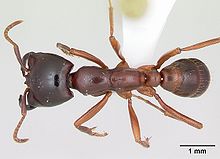| Dorylinae | |
|---|---|

| |
| D. gribodoi | |
| Scientific classification | |
| Domain: | Eukaryota |
| Kingdom: | Animalia |
| Phylum: | Arthropoda |
| Class: | Insecta |
| Order: | Hymenoptera |
| Family: | Formicidae |
| Subfamily: | Dorylinae Leach, 1815 |
| Type genus | |
| Dorylus Fabricius, 1793
| |
| Diversity[1] | |
| 28 genera | |
Dorylinae is an ant subfamily, with distributions in both the Old World and New World. Brady et al. (2014) synonymized the previous dorylomorph subfamilies (Aenictinae, Aenictogitoninae, Cerapachyinae, Ecitoninae, and Leptanilloidinae) under Dorylinae,[2] while Borowiec (2016) reviewed and revised the genera, resurrecting many genera which had previously been merged.[3] Dorylinae genera are suggested to have evolved sometime between 102 to 74 million years ago, subsequently undergoing rapid adaptive radiation events during their early history.[2]
Genera
[edit]- Acanthostichus Mayr, 1887
- Aenictogiton Emery, 1901
- Aenictus Shuckard, 1840
- Cerapachys Smith, 1857
- Cheliomyrmex Mayr, 1870
- Chrysapace Crawley, 1924
- Cylindromyrmex Mayr, 1870
- Dorylus Fabricius, 1793
- Eburopone Borowiec, 2016
- Eciton Latreille, 1804
- Eusphinctus Emery, 1893
- Labidus Jurine, 1807
- Leptanilloides Mann, 1923
- Lioponera Mayr, 1879
- Lividopone Bolton & Fisher, 2016
- Neivamyrmex Borgmeier, 1940
- Neocerapachys Borowiec, 2016
- Nomamyrmex Borgmeier, 1936
- Ooceraea Roger, 1862
- Parasyscia Emery, 1882
- †Procerapachys Wheeler, 1915
- Simopone Forel, 1891
- Sphinctomyrmex Mayr, 1866
- Syscia Roger, 1861
- Tanipone Bolton & Fisher, 2012
- Vicinopone Bolton & Fisher, 2012
- Yunodorylus Xu, 2000
- Zasphinctus Wheeler, 1918
References
[edit]- ^ Bolton, B. (2016). "Dorylinae". AntCat. Retrieved 19 October 2016.
- ^ a b Brady, Seán G; Fisher, Brian L; Schultz, Ted R; Ward, Philip S (2014). "The rise of army ants and their relatives: diversification of specialized predatory doryline ants". BMC Evolutionary Biology. 14 (1): 2–14. Bibcode:2014BMCEE..14...93B. doi:10.1186/1471-2148-14-93. PMC 4021219. PMID 24886136.
- ^ Borowiec, M. (2016). "Generic revision of the ant subfamily Dorylinae (Hymenoptera, Formicidae)". ZooKeys (608): 1–280. Bibcode:2016ZooK..608....1B. doi:10.3897/zookeys.608.9427. PMC 4982377. PMID 27559303.
External links
[edit] Media related to Dorylinae at Wikimedia Commons
Media related to Dorylinae at Wikimedia Commons
Well, that’s interesting to know that Psilotum nudum are known as whisk ferns. Psilotum nudum is the commoner species of the two. While the P. flaccidum is a rare species and is found in the tropical islands. Both the species are usually epiphytic in habit and grow upon tree ferns. These species may also be terrestrial and grow in humus or in the crevices of the rocks.
View the detailed Guide of Psilotum nudum: Detailed Study Of Psilotum Nudum (Whisk Fern), Classification, Anatomy, Reproduction